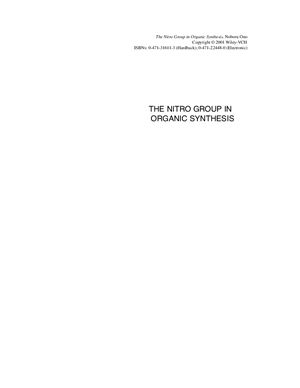2001 Wiley-VCH, 372 с.
The purpose of this book is to emphasize recent important advances in organic synthesis using nitro compounds. Historically, it was aromatic nitro compounds that were prominent in organic synthesis. In fact they have been extensively used as precursors of aromatic amines and their derivatives, and their great importance in industrial and laboratory applications has remained.
This book is not intended to be a comprehensive review of established procedures, but it aims to emphasize new important methods of using nitro compounds in organic synthesis.
The most important progress in the chemistry of nitro compounds is the improvement of their preparations; this is discussed in chapter
2. Environmentally friendly methods for nitration are emphasized here.
In recent years, the importance of aliphatic nitro compounds has greatly increased, due to the discovery of new selective transformations. These topics are discussed in the following chapters: Stereoselective Henry reaction (chapter 3.3), Asymmetric Micheal additions (chapter 4.4), use of nitroalkenes as heterodienes in tandem [4+2]/[3+2] cycloadditions (chapter 8) and radical denitration (chapter 7.2). These reactions discovered in recent years constitute important tools in organic synthesis. They are discussed in more detail than the conventional reactions such as the Nef reaction, reduction to amines, synthesis of nitro sugars, alkylation and acylation (chapter 5). Conceing aromatic nitro chemistry, the preparation of substituted aromatic compounds via the SNAr reaction and nucleophilic aromatic substitution of hydrogen (VNS) are discussed (chapter 9). Preparation of heterocycles such as indoles, are covered (chapter 10).
Preparation of Nitro Compounds
The Nitro-Aldol (Henry) Reaction
Michael Addition
Alkylation, Acylation, and Halogenation of Nitro Compounds
Conversion of Nitro Compounds into Other Compounds
Substitution and Elimination of NO2 in R-NO2
Cycloaddition Chemistry of Nitro Compounds
Nucleophilic Aromatic Displacement
Synthesis of Heterocyclic Compounds
The purpose of this book is to emphasize recent important advances in organic synthesis using nitro compounds. Historically, it was aromatic nitro compounds that were prominent in organic synthesis. In fact they have been extensively used as precursors of aromatic amines and their derivatives, and their great importance in industrial and laboratory applications has remained.
This book is not intended to be a comprehensive review of established procedures, but it aims to emphasize new important methods of using nitro compounds in organic synthesis.
The most important progress in the chemistry of nitro compounds is the improvement of their preparations; this is discussed in chapter
2. Environmentally friendly methods for nitration are emphasized here.
In recent years, the importance of aliphatic nitro compounds has greatly increased, due to the discovery of new selective transformations. These topics are discussed in the following chapters: Stereoselective Henry reaction (chapter 3.3), Asymmetric Micheal additions (chapter 4.4), use of nitroalkenes as heterodienes in tandem [4+2]/[3+2] cycloadditions (chapter 8) and radical denitration (chapter 7.2). These reactions discovered in recent years constitute important tools in organic synthesis. They are discussed in more detail than the conventional reactions such as the Nef reaction, reduction to amines, synthesis of nitro sugars, alkylation and acylation (chapter 5). Conceing aromatic nitro chemistry, the preparation of substituted aromatic compounds via the SNAr reaction and nucleophilic aromatic substitution of hydrogen (VNS) are discussed (chapter 9). Preparation of heterocycles such as indoles, are covered (chapter 10).
Preparation of Nitro Compounds
The Nitro-Aldol (Henry) Reaction
Michael Addition
Alkylation, Acylation, and Halogenation of Nitro Compounds
Conversion of Nitro Compounds into Other Compounds
Substitution and Elimination of NO2 in R-NO2
Cycloaddition Chemistry of Nitro Compounds
Nucleophilic Aromatic Displacement
Synthesis of Heterocyclic Compounds

